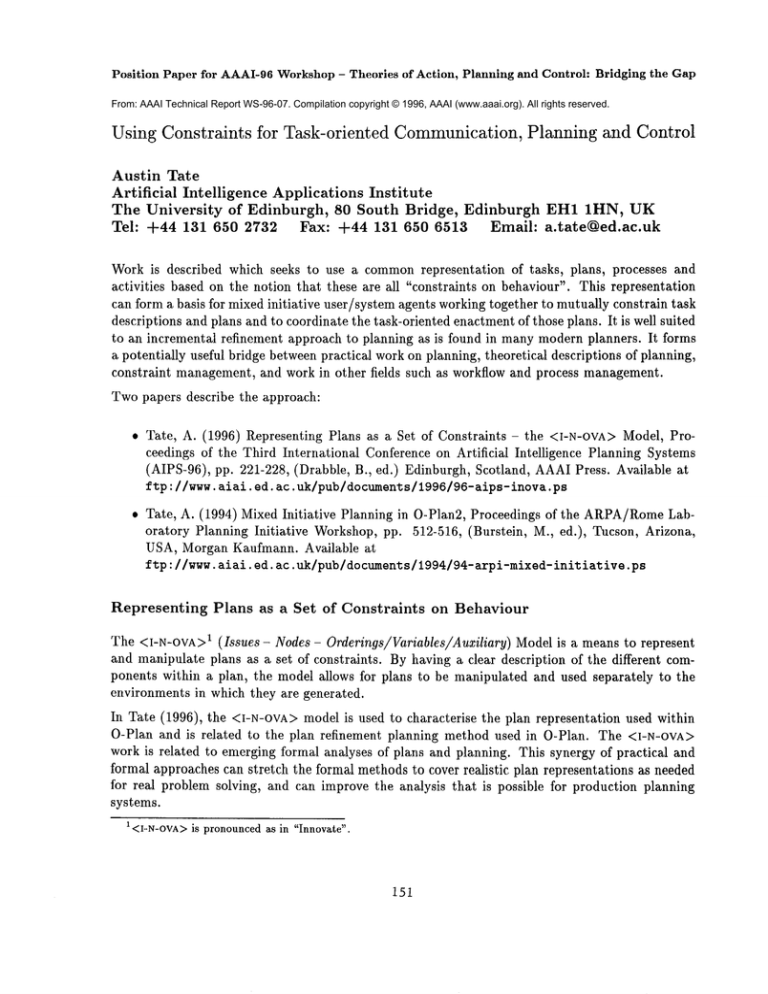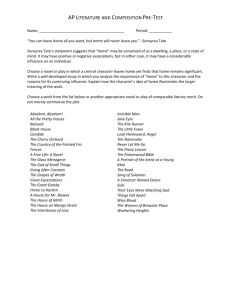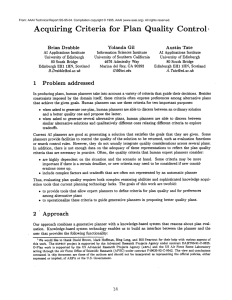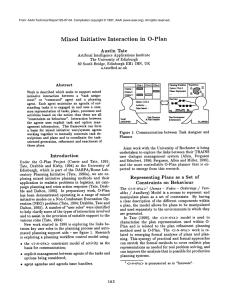
Position Paper for AAAI-96Workshop- Theories of Action, Planning and Control: Bridging the Gap
From: AAAI Technical Report WS-96-07. Compilation copyright © 1996, AAAI (www.aaai.org). All rights reserved.
Using Constraints
for Task-oriented
Communication, Planning and Control
Austin Tate
Artificial
Intelligence
Applications Institute
The University
of Edinburgh,
80 South Bridge,
Edinburgh EH1 1HN, UK
Tel: -t-44 131 650 2732 Fax: -4-44 131 650 6513 Email: a.tate@ed.ac.uk
Work is described which seeks to use a commonrepresentation of tasks, plans, processes and
activities based on the notion that these are all "constraints on behaviour". This representation
can form a basis for mixed initiative user/system agents working together to mutually constrain task
descriptions and plans and to coordinate the task-oriented enactment of those plans. It is well suited
to an incremental refinement approach to planning as is found in many modern planners. It forms
a potentially useful bridge between practical work on planning, theoretical descriptions of planning,
constraint management, and work in other fields such as workflow and process management.
Twopapers describe the approach:
Tate, A. (1996) Representing Plans as a Set of Constraints - the <:I-N-OVA> Model, Proceedings of the Third International Conference on Artificial Intelligence Planning Systems
(AIPS-96), pp. 221-228, (Drabble, B., ed.) Edinburgh, Scotland, AAAIPress. Available
ftp ://www.aiai.ed. ac .uk/pub/documents/1996/96-aips-inova.
ps
Tate, A. (1994) Mixed Initiative Planning in O-Plan2, Proceedings of the ARPA/Rome
Laboratory Planning Initiative Workshop, pp. 512-516, (Burstein, M., ed.), Tucson, Arizona,
USA, Morgan Kaufmann. Available at
ftp://www.aiai.ed. ac.uk/pub/document
s/1994/94-arpi-mixed-init
iative.ps
Representing
Plans
as a Set of Constraints
on Behaviour
The <I-N-OVA> 1 (IssuesNodes- Orderings/Variables/Auxiliary)
Model is a means to represent
and manipulate plans as a set of constraints. By having a clear description of the different components within a plan, the model allows for plans to be manipulated and used separately to the
environments in which they are generated.
In Tate (1996), the <I-N-OVA> model is used to characterise the plan representation used within
O-Plan and is related to the plan refinement planning method used in O-Plan. The <I-N-OVA>
work is related to emerging formal analyses of plans and planning. This synergy of practical and
formal approaches can stretch the formal methods to cover realistic plan representations as needed
for real problem solving, and can improve the analysis that is possible for production planning
systems.
1 <I-N-OVA> is
pronounced
as
in "Innovate".
151
<I-N-OVA>is intended to act as a bridge to improve dialogue between a number of communities
working on formal planning theories, practical planning systems and systems engineering process
management methodologies. It is intended to support new work on automatic manipulation of
plans, humancommunication about plans, principled and reliable acquisition of plan information,
and formal reasoning about plans.
A plan is represented as a set of constraints which together limit the behaviour that is desired when
the plan is executed. The set of constraints are of three principal types with a numberof sub-types
reflecting practical experience in a numberof planning systems.
Plan Constraints
I - Implied Constraints
N - Node Constraints
GVA - DetailedConstraints
0 - OrderingConstraints
V - VariableConstraints
A - AuxiliaryConstraints
- AuthorityConstraints
- ConditionConstraints
- ResourceConstraints
- Other Constraints
The node constraints (these are often of the form "include activity") in the <I-N-OVA>
model set
the space within which a plan may be further constrained. The I (issues) and ova constraints
restrict the plans within that space which are valid. Ordering (temporal) and variable constraints
are distinguished from all other auxiliary constraints since these act as cross-constraints, usually
being involved in describing the others - such as in a resource constraint which will often refer to
plan objects/variables and to time points or ranges.
Mutually
Constraining
Plans
for
Mixed Initiative
Planning
and Control
The model of Mixed Initiative
Planning that can be supported by the approach is the mutual
constraining of behaviour by refining a set of alternative partial plans. Users and systems can work
in harmony though employing a commonview of their roles as being to constrain the space of
admitted behaviour. Further detail is given in Tare (1994).
Workflowordering and priorities can be applied to imposespecific styles of authority to plan within
the system. One extreme of user driven plan expansion followed by system "filling-in" of details, or
the opposite extreme of fully automatic system driven planning (with perhaps occasional appeals
to an user to take predefined decisions) are possible. In more practical use, we envisage a mixed
initiative form of interaction in which users and systems proceed by mutually constraining the plan
using their ownareas of strength.
152





